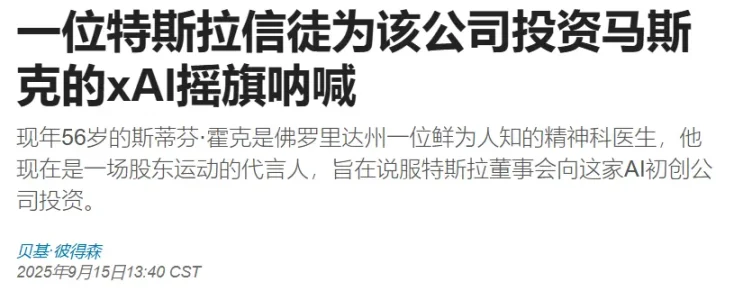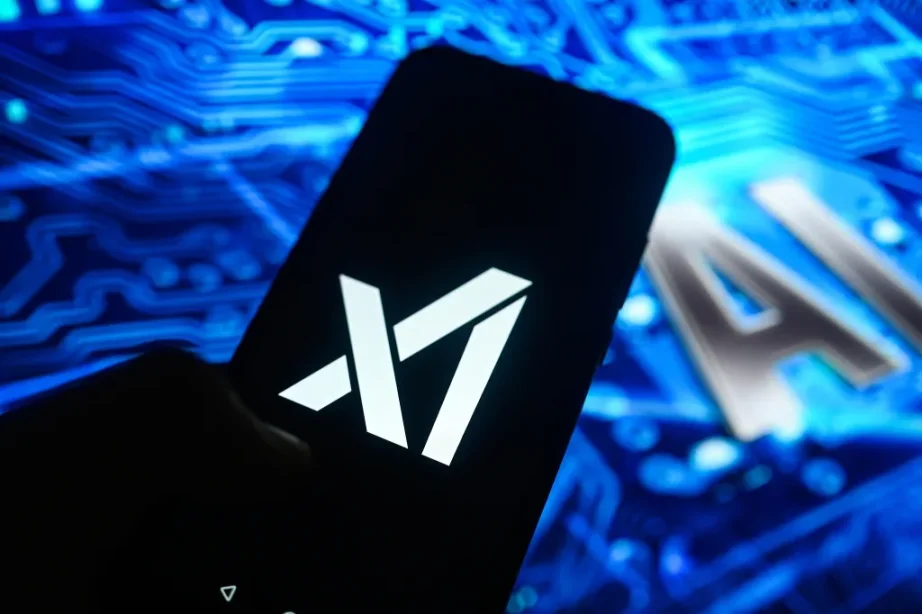Author: Silicon Rabbit
In the world of technology and capital, some rumors start as whispers in enthusiast forums, then ferment into speculative stories in financial media, and ultimately, they find their way onto the most serious agendas that cannot be ignored.
The merger between Tesla and Musk's other AI startup, xAI, is such a prophecy that is gradually becoming a reality.
Last Sunday, a tweet from Anthony Scaramucci, founder of SkyBridge Capital, added fuel to this already heated expectation. He bluntly stated that as Musk accelerates the integration of AI into his business landscape, the merger between Tesla and xAI "feels inevitable."

This is not an isolated shout. When a shareholder proposal urging Tesla to invest in xAI was formally submitted, and when Morgan Stanley uncovered hidden "merger clauses" in Musk's new compensation plan, which could be worth up to a trillion dollars, everyone realized: an AI giant spanning the digital and physical worlds, potentially valued at $8.5 trillion, is emerging.
Is this a fantasy of capital, or is it Musk's strategic layout? Today, Silicon Rabbit, in conjunction with discussions with its expert team, will delve into the possibility of this century merger and what it signifies for the future of AI.
Merging a hotshot with a valuation of $100 billion (xAI) into a trillion-dollar giant (Tesla) is no small feat. We can clearly see how this path has been paved step by step through four key signals.
1. A Proposal: From Grassroots Voices to Formal Agenda
It all began with a Tesla retail shareholder named Stephen Hawk. He submitted a formal proposal suggesting that the company invest in xAI, which will be voted on at the company's annual shareholder meeting on November 6.

This seemingly insignificant step carries immense symbolic significance. It marks the first time the "capital union between Tesla and xAI" has moved from public discourse into the formal agenda of corporate governance.
As Hawk himself stated, his inspiration came from Musk's hints on social media. He believes that "formally establishing this partnership is crucial to ensuring clear mutual benefits." This represents the voice of the most loyal investors: our investment in Tesla is an investment in Musk's AI vision, and we do not want xAI's tremendous success to be unrelated to us.
2. Trillion-Dollar Compensation: The "Merger Clause" Hidden in the Devil's Details
If the shareholder proposal is a "bottom-up" push, then Musk's new ten-year compensation plan is a "top-down" design. This plan is seen by top investment banks like Morgan Stanley as the "key" to unlocking the merger mystery.
Morgan Stanley analyst Adam Jonas astutely pointed out that a supplementary clause regarding acquisitions in the plan is key to solving the puzzle:
"The market cap and adjusted EBITDA milestone targets may be adjusted to account for Tesla acquisition activities deemed to have a significant impact on milestone achievement."
This convoluted text translates to: if Tesla makes a "significant" acquisition in the future (such as xAI), then Musk's performance assessment targets can be adjusted accordingly.
Wall Street's interpretation is straightforward: this is the most flexible institutional interface reserved for a future merger with xAI. It indicates that this potential merger has long been in Tesla's long-term strategic toolbox, just waiting for the right moment.
3. Musk's 25% Control
Musk himself has not hidden his open attitude towards the merger. He has publicly solicited opinions from fans on the X platform and has told investors that he "will act according to the will of shareholders."
Behind this is his deep consideration of Tesla's control. Musk has repeatedly stated that he wants to hold at least 25% of Tesla's shares to have a veto vote in any change of control. However, simply increasing his stake in the secondary market is extremely costly.
By merging with xAI, this problem can be perfectly solved. Musk holds a significant stake in xAI, and if xAI is acquired by Tesla, his xAI shares will be correspondingly exchanged for new Tesla shares. This not only significantly increases his ownership ratio but also addresses investors' concerns about his divided attention, firmly locking all core businesses within Tesla as the main platform—killing two birds with one stone.
4. Wall Street's Excitement
The capital market's pursuit of stories is greedy. When renowned analyst Gene Munster from Deepwater Asset Management raised his voice, claiming that "the combination of Tesla and xAI could help the former's market value reach $8.5 trillion," the entire Wall Street was ignited.
The underlying viewpoint is a fundamental reassessment of Tesla's business model—it will no longer be seen merely as an electric vehicle or energy company, but as a truly integrated AI platform company that combines software and hardware. Such a company should enjoy a valuation premium far exceeding that of traditional manufacturing.
Market enthusiasm must be built on solid business logic. The merger between Tesla and xAI is considered a "match made in heaven" because they occupy opposite ends of the AI world, each being the most needed piece of the other's puzzle.
1. The Final Piece of the Puzzle
Musk has emphasized more than once that Tesla is a "real-world AI company." Its core mission is to enable AI to understand and interact with the physical world. This is specifically reflected in:
Autonomous Driving (FSD): Teaching cars to see, understand, and make decisions in complex physical traffic environments.
Humanoid Robots (Optimus): Robots performing tasks in unstructured physical spaces like factories and homes.
On the other hand, xAI focuses on "AI in the digital world." Its core product, the Grok large language model, aims to understand and generate human language, code, and logic.

For hardware carriers like Optimus, the perception and execution capabilities in the physical world are its "body," while the cognitive and reasoning abilities of the language model are its "soul."
Only when the two are deeply integrated can it understand complex instructions and break them down into actions. The merger between Tesla and xAI aims to create such a "unified body and mind" general AI entity.
2. The Ultimate Closed Loop from "Seeing" to "Understanding"
The competition in AI ultimately boils down to a competition for data. Tesla possesses the largest and still exponentially growing real-world driving video data, which is the most valuable resource for training AI in the physical world.
However, this data has mostly been used for training "perception" tasks, such as recognizing vehicles, pedestrians, and lane markings. After merging with xAI, Grok's powerful multimodal capabilities can perform deeper "annotation" and "understanding" of these vast video data, forming an unparalleled data flywheel:
Tesla's fleet collects massive video data -> Grok model deeply understands and logically annotates the videos in the cloud -> Trains smarter FSD and Optimus models -> Deploys to the fleet and robots, performing better, thus encouraging more users to use and generate higher quality data -> This cycle continues, evolving exponentially.
Once this flywheel starts turning, its high barriers will leave any competitors in the dust.
3. Deep Coupling of Software and Hardware
The ultimate outcome of the large model competition will be a race for vertical integration of software and hardware. You not only need the best algorithms but also the most efficient chips and data center architectures tailored for your algorithms.
Tesla has its self-developed Dojo chip, and xAI has the Grok model. After the merger, they can achieve extreme optimization from bottom-level chip design to data center construction to upper-level model training, converting every watt of energy into effective computing power.
In fact, the synergy between the two companies has already quietly begun: Grok has been integrated into some Tesla vehicles and Optimus prototypes; and xAI's computing power center is stably supplied by Tesla Energy's Megapack industrial energy storage batteries.
When all logic points to the merger, the remaining question is: when and how.
For Tesla's shareholders, this is an urgent issue to be resolved. As xAI's valuation skyrockets from tens of billions to seeking $200 billion in new financing, and as Tesla investors, they cannot directly share in the maximum dividends of this AI revolution, it is undoubtedly a torment.
The merger between Tesla and xAI is far from a simple "left hand to right hand" capital game. It is an inevitable step for Musk to build an unprecedented AI vertical integration empire, spanning from bottom-level energy to custom chips, to supercomputing power, and finally landing on the two physical carriers of cars and robots.
The shareholder meeting on November 6 will be a key node in this grand drama. Regardless of the voting outcome, what we are witnessing may not just be a corporate restructuring, but the dawn of a new AI era.
免责声明:本文章仅代表作者个人观点,不代表本平台的立场和观点。本文章仅供信息分享,不构成对任何人的任何投资建议。用户与作者之间的任何争议,与本平台无关。如网页中刊载的文章或图片涉及侵权,请提供相关的权利证明和身份证明发送邮件到support@aicoin.com,本平台相关工作人员将会进行核查。




